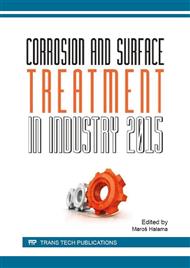p.3
p.7
p.13
p.19
p.27
p.31
p.38
p.46
The Influence of Alloying Elements with Shape Memory Effect on Corrosion-Mechanical Properties of Welded Joints
Abstract:
The article contains analysis results of destruction of chemical generator corps representing thin-walled pressure vessels working under cyclic loading and in corrosive environments. It is shown that the corps made of steel 321 was destroyed mainly along the weld and heat affected zone. To improve the durability of corps we used materials with shape memory effect (SME) based on NiTi as alloying compound of welds. This allowed us to combine the functional properties of alloys with shape memory effect with increased mechanical, technological and operational properties. Accomplished electrochemical studies of corrosion behavior of steel 321 samples alloyed with NiTi in 3.5% NaCl solution, showed that the corrosion rate of welded joint and the base material are comparable. Fatigue tests in the environment KOH + H2 showed a significant reduction of ductility, which indicates the presence of hydrogen embrittlement. With increasing degree of hydrogenation the fatigue life of alloyed compounds drastically reduces.
Info:
Periodical:
Pages:
13-18
Citation:
Online since:
March 2016
Keywords:
Price:
Сopyright:
© 2016 Trans Tech Publications Ltd. All Rights Reserved
Share:
Citation:


